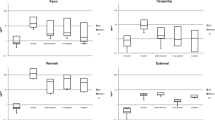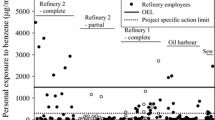Abstract
Emission levels of vapours and aerosols of bitumen are different when processing rolled asphalt compared to mastic asphalt, with working temperatures up to 180 and 250°C, respectively. During the Human Bitumen Study, we examined six workers handling rolled asphalt and mastic asphalt in two consecutive weeks at the same construction site in a tunnel. In addition to the determination of exposure to bitumen and polycyclic aromatic hydrocarbons (PAH) during shift, we examined urinary PAH metabolites, irritative and genotoxic effects before and after shift. Median personal shift concentration of vapours and aerosols of bitumen was 1.8 (range 0.9–2.4) mg/m3 during the application of rolled asphalt and 7.9 (range 4.9–11.9) mg/m3 when mastic asphalt was applied. Area measurement of vapours and aerosols of bitumen revealed higher concentrations than the personal measurements for mastic asphalt (mastic asphalt: 34.9 mg/m3; rolled asphalt: 1.8 mg/m3). Processing mastic asphalt was associated also with higher PAH concentrations. Urinary 1-hydroxypyrene and the sum of 1-, 2+ 9-, 3- and 4-hydroxyphenanthrene increased slightly during shift without clear difference between mastic and rolled asphalt application. However, the post-shift urinary PAH-metabolite concentrations did not reflect the different PAH exposure during mastic and rolled asphalt application. Individual workers could be identified by their spirometry results indicating that these data reflect more chronic than acute effects. In most cases, an increase of 8-oxodGuo adducts was observed during shift that was independent of the asphalt application. 8-oxodGuo and (+)-anti-BPDE-DNA adducts were higher than in exposed workers of the Human Bitumen Study independent of the asphalt application. The DNA-strand breaks were considerably higher pre-shift and decreased during shift. In this study, mastic asphalt application led to significantly higher exposure to vapours and aerosols of bitumen, as well as to airborne PAH, compared to rolled asphalt application. Nevertheless, no differences in the excretion of urinary PAH metabolites, lung function impairment and genotoxic markers were detected. However, higher levels of genotoxicity markers on both examination days compared with the results of the Human Bitumen Study may indicate a possible influence of the specific tunnel setting.





Similar content being viewed by others
References
Bouchard M, Krishnan K, Vian C (1998) Kinetics of tissue distribution and elimination of pyrene and 1-hydroxypyrene following intravenous administration of [14c]pyrene in rats. Toxicol Sci 46:11–20
Breuer D (2008) Bitumen (Dämpfe und Aeorosole, Mineralöl-Standard). BGIA Arbeitsmappe digital 6305/1
Breuer D, Hahn JU, Höber D, Emmel C, Musanke U, Rühl R, Spickenheuer A, Raulf-Heimsoth M, Bramer R, Seidel A, Schilling B, Heinze E, Kendzia B, Marczynski B, Welge P, Angerer J, Brüning T, Pesch B (2011) Air sampling, analytical methodology and measurement strategy for bitumen and polycyclic aromatic hydrocarbons vapours and aerosols. Arch Toxicol (in press)
Burstyn I, Kromhout H (2000) Are the members of a paving crew uniformly exposed to bitumen fume, organic vapour, and Benzo(a)pyrene? Risk Anal 20:653–663
Deutsche Forschungsgemeinschaft (2003) Analytische Methoden zur Prüfung gesundheitsschädlicher Arbeitsstoffe. Luftanalysen. Polycyclische aromatische Kohlenwasserstoffe (PAH). Meth.-Nr. 3 PAH. [Hrsg.: Greim, H] Wiley-VCH, Weinheim. 13. Lieferung
Lintelmann J, Angerer J (1999) PAH metabolites. In: Angerer J, Schaller KH (eds) Analysis of hazardous substances in biological materials, vol 6. Wiley-VCH, Weinheim, pp 163–187
Marczynski B, Rihs HP, Rossbach B, Hölzer J, Angerer J, Scherenberg M, Hoffmann G, Brüning T, Wilhelm M (2002) Analysis of 8-oxo-7, 8-dihydro-2’-deoxyguanosine and DNA strand breaks in white blood cells of occupationally exposed workers: comparison with ambient monitoring, urinary metabolites and enzyme polymorphisms. Carcinogenesis 23:273–281
Marczynski B, Raulf-Heimsoth M, Preuss R, Kappler M, Schott K, Pesch B, Zoubek G, Hahn JU, Mensing T, Angerer J, Käfferlein HU, Brüning T (2006) Assessment of DNA damage in WBCs of workers occupationally exposed to fumes and aerosols of bitumen. Cancer Epidemiol Biomarkers Prev 15:645–651
Marczynski B, Raulf-Heimsoth M, Spickenheuer A, Pesch B, Kendzia B, Mensing T, Engelhardt B, Lee EH, Schindler B, Heinze E, Welge P, Bramer R, Breuer D, Angerer J, Käfferlein HU, Brüning T (2011) DNA adducts and strand breaks in workers exposed to vapours and aerosols of bitumen: association between exposure and effect. Arch Toxicol (in press)
NIOSH (2000) Health effects of occupational exposure to asphalt. NIOSH-Publications Dissemination, Cincinnati
Östling O, Johanson KJ (1984) Microelectrophoretic study of radiation-induced DNA damages in individual mammalian cells. Biochem Biophys Res Commu 123:291–298
Pesch B, Spickenheuer A, Kendzia B, Schindler BK, Welge P, Marczynski B, Rihs HP, Raulf-Heimsoth M, Angerer J, Brüning T (2011) Urinary metabolites of polycyclic aromatic hydrocarbons in workers exposed to vapours and aerosols of bitumen. Arch Toxicol (in press)
Raulf-Heimsoth M, Angerer J, Pesch B, Marczynski B, Hahn JU, Spickenheuer A, Preuss R, Rühl R, Rode P, Brüning T (2008) Biological monitoring as a useful tool for the detection of a coal-tar contamination in bitumen-exposed workers. J Toxicol Environ Health 71:746–750
Raulf-Heimsoth M, Pesch B, Rühl R, Brüning T (2011a) The human Bitumen study: executive summary. Arch Toxicol (in press)
Raulf-Heimsoth M, Pesch B, Kendzia B, Spickenheuer A, Bramer R, Marczynski B, Merget R, Brüning T (2011b) Irritative effects of vapours and aerosols of bitumen on the airways assessed by non-invasive methods. Arch Toxicol (in press)
Rojas M, Alexandrov K, Cascorbi I, Brockmöller J, Likhachev A, Pozharisski K, Bouvier G, Auburtin G, Mayer L, Kopp-Schneider A, Roots I, Bartsch H (1998) High benzo[a]pyrene diol epoxide DNA adduct levels in lung and blood cells from subjects with combined CYP1A1 MspI/Msp/I-GSTM1*0/*0 genotypes. Pharmacogenetics 8:109–118
Rühl R, Musanke U, Kolmsee K, Prieß R, Zoubek G, Breuer D (2006) Vapours and aerosols of bitumen: exposure data obtained by the German Bitumen Forum. Ann Occup Hyg 50:459–468
Singh NP, McCoy MT, Tice RR, Schneider EL (1988) A simple technique for quantitation of low levels of DNA damage in individual cells. Exp Cell Res 175:184–191
Spickenheuer A, Rühl R, Höber D, Raulf-Heimsoth M, Marczynski B, Welge P, Breuer D, Gabriel S, Musanke U, Rode P, Heinze E, Kendzia B, Bramer R, Knecht U, Hahn JU, Brüning T, Pesch B (2011) Levels and determinants of exposure to vapours and aerosols of bitumen. Arch Toxicol (in press)
Acknowledgments
The Human Bitumen Study was initiated by the German Committee for Hazardous Substances (AGS) and the German Bitumen Forum and financially supported by German Social Accident Insurance (DGUV), Eurobitume, Deutscher Asphaltverband e.V., Concawe, Zentralverband des Deutschen Dachdeckerhandwerks, Industrieverband Bitumen-, Dach- und Dichtungsbahnen e.V., Berufsgenossenschaft Rohstoffe und Chemische Industrie (BG RCI) and Aksys GmbH, Beratungsstelle Gussasphaltanwendungen (bga), BG BAU, Arbeitsgemeinschaft der Bitumenindustrie (Arbit). We thank all workers having participated in the Human Bitumen Study. We gratefully acknowledge the technical support of the field team, especially Anne Flagge, Anja Molkenthin, Bianca Wachter, Dieter Höber and the laboratory staff Gerda Borowitzki, Maria Düser, Susanne Freundt, Sabine Bernard, Heike Stubel and Helga Hut for their skilful technical assistance and/or the data entry.
Author information
Authors and Affiliations
Corresponding author
Rights and permissions
About this article
Cite this article
Raulf-Heimsoth, M., Marczynski, B., Spickenheuer, A. et al. Bitumen workers handling mastic versus rolled asphalt in a tunnel: assessment of exposure and biomarkers of irritation and genotoxicity. Arch Toxicol 85 (Suppl 1), 81–87 (2011). https://doi.org/10.1007/s00204-011-0685-2
Received:
Accepted:
Published:
Issue Date:
DOI: https://doi.org/10.1007/s00204-011-0685-2




